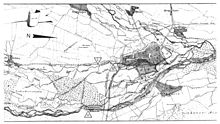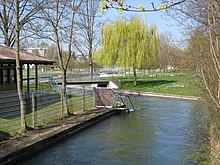Capital stream
The Hauptstadtbach , formerly just called Stadtbach , is a left channel of the Lech in Augsburg and part of Augsburg's historical water management . With up to 45 cubic meters of water per second at the inlet canal, it is the most powerful section of the system of canals in Augsburg . The capital stream flows in the Augsburg-Spickel-Herrenbach planning area and feeds most of the Lech canals in Augsburg's old town and the canals in Augsburg's textile district .
meaning
The capital stream has been used for rafting since the Middle Ages and thus supplied Augsburg with goods and raw materials from the south, as well as the regions downstream with goods from Augsburg. Its hydropower was also used to power mills and craft businesses. The sewer system was also of fundamental importance for the city from a hygienic point of view. There were always bitter disputes between the imperial city of Augsburg and Bavaria over the derivation of the Lech to Augsburg. Its importance increased again in the 19th century when water power became a prerequisite for the flourishing textile industry in the east of Augsburg. These historical uses are symbolized by the sculptures “Flößer” and “Spinnerin” on the west bank of the Hochablasswehr , the beginning of the capital stream.
Today, the water of the capital stream and its downstream canals is used for energy in several dozen hydropower plants in the city of Augsburg. In its first section since 1972, it has also been used for canoeing .
course
The capital stream begins at the Hochablass . Its first section is also called the inlet channel . From here a canal, the Neubach , branches off to the left to the Hochablass waterworks and flows back into the capital stream. Today this former waterworks for the promotion and treatment of drinking water is a hydropower plant for generating electricity, it also houses a technology museum and an information center for Augsburg's drinking water supply.
The Neubach has existed since 1879. Before 1912, however, it was derived from the Lech a little further upstream as a separate tap from the capital stream.
The Augsburger Eiskanal branches off to the right from the capital stream and leads back into the Lech . It originally served as a bypass channel for drift ice so that it would not damage the turbines of the waterworks at Hochablass in winter. In 1971 it was converted into a canoe route for the 1972 Summer Olympics . Today canoeists use not only the ice canal, but also the capital stream and the Neubach as canoe routes. They refer to the Neubach in front of the waterworks as the “baby route”, the Neubach after the waterworks as the “forest route”, the capital stream in this area as the “youth route” and the ice canal as the “Olympic route”.
After the re-confluence of the Neubach, the Hauptstadtbach flows under the Munich – Augsburg railway line , which crosses the Lech, and at the same time leaves the Siebentischwald . Here is a section designed for swimming area, with a station of the Coast Guards on Damaschkeplatz. You can enter and leave the canal via bathing ladders, but the current is extremely strong, as 35 cubic meters of water flow here per second. At the end of the route, a wire rope is stretched across the canal.
On Friedberger Straße, the capital stream divides into two arms, the Kaufbach and the Herrenbach .
Kaufbach
The Kaufbach has about 14 cubic meters of water per second and flows parallel to the left of Friedberger Straße towards Augsburg's old town. At its beginning on Damaschkeplatz is the technical monument Pulvermühlschleuse . This is named after a powder mill that was here until the 19th century.
In front of the Augsburg Ring freight yard of the Augsburger Localbahn , the Schäfflerbach divides from Kaufbach to the right . After the local railway line crosses the Kaufbach, it flows through the Fribbe outdoor pool , where it is once again used as a swimming pool .
The Kaufbach passes under it near the beginning of Friedberger Straße. The Wolfsbach , which branches off from the Lochbach, flows into it here. After Prinzstrasse, the Kaufbach is divided into the Schwalllech , which leads into the Lechviertel of the old town at the former Schwibbogentor , and the Sparrenlech , which flows into the Jakobervorstadt near the Vogeltor .
Herrenbach
The Herrenbach feeds the canals of Augsburg's textile district . It carries around 21 cubic meters of water per second. It crosses under Friedberger Strasse and flows north in the Augsburg-Wolfram- and Herrenbachviertel district . Up until the 1950s, it was mainly nurseries that could be found here. These were replaced by large residential complexes in the 1960s. The Herrenbachstraße runs parallel to the Herrenbach, with the Herrenbach allotment garden in between .
After the Geisbergschleuse on Reichenberger Straße, next to the factory lock , it is divided into the Hanreibach and the Proviantbach .



